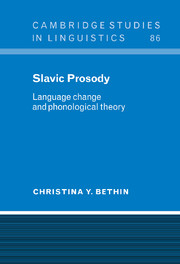Book contents
1 - The syllable in Slavic: form and function
Published online by Cambridge University Press: 07 September 2010
Summary
Background
Slavists agree that the syllable played a major role in the history of the Slavic languages and there are various principles, tendencies, and laws to explain how sound change related to syllable structure in Common Slavic. But our understanding of the syllable in Slavic is still fairly rudimentary. After Leskien (1909: 52ff.) observed that several developments in Proto- and Common Slavic had the effect of converting closed syllables to open ones, Iljinskij (1916, 1926) associated the loss of final consonants, the simplification of consonant clusters, the monophthongization of diphthongs, the changes in liquid diphthongs, and the creation of nasal vowels and syllabic liquids with a “law of open syllables.” By formulating this “law” as a “principle of rising sonority,” van Wijk (1931) was able to include the prothesis of glides among the series of innovations consistent with a certain syllable type. Other changes, including palatalization and vowel fronting, seemed to produce a similarity between sounds within a syllable and in 1929 Jakobson extended our understanding of the syllable as a phonological domain by referring to these changes as being consistent with a “tendency for syllable synharmony.” Slavists since then have viewed the development of Common Slavic from Proto-Indo-European (PIE) as governed by open syllable structure or rising sonority, and syllable synharmony. It is also widely claimed that the loss of certain vowels (jers) in Late Common Slavic (LCS) thoroughly restructured the phonological system of Slavic, creating newly closed syllables.
- Type
- Chapter
- Information
- Slavic ProsodyLanguage Change and Phonological Theory, pp. 12 - 111Publisher: Cambridge University PressPrint publication year: 1998



